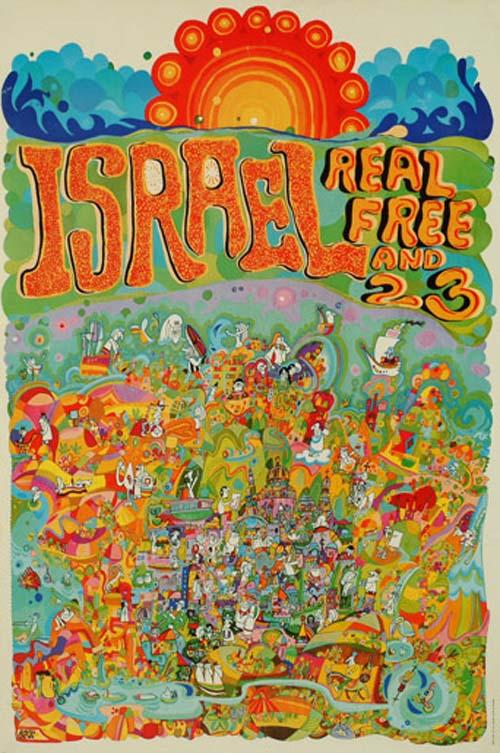The first poster is by caricaturist and designer Dudu Geva (1950–2005), printed in 1971 for Israel’s 23rd Independence Day. This English-language poster was commissioned by the Ministry of Education’s Publicity Department, and the slogan “Israel: Real, Free and 23” indicates that it was intended for audiences abroad.
Stylistically, it is closely associated with 1960s “Hippy” posters that were characterized by dense, swirling patterning, and an abundant use of bold colors, such as magenta and cyan. The poster was created in the interim between the War of Attrition and the Yom Kippur War. As a consequence of the Six-Day War, this period witnessed some markedly euphoric and optimistic cultural manifestations. Geva’s joyful poster accordingly depicts a rising sun and is packed with smiling figures. Jerusalem is depicted in its center with the Red Sea, the Dead Sea, the Lake of Galilee, and the Mediterranean abstractly condensed around it, in a map-like arrangement. Maps frequently appeared in posters; they symbolized the state and their delineation of borders and choice of locales carried political significance.
The articulation of geography and territory in this poster is unique, as Geva draws a state without borders, avoiding their definition and thus representing a momentarily carefree Israel. This collapse of the familiar representation of national borders is comparable to other cultural manifestations, which following the Six-Day War connoted a new sense of a “borderless” geographic space. Geva portrays diversity in an uncompromising manner. Architecture again plays a central role: the Dome of the Rock and the Tower of David are placed at the center of the composition.
Unlike Cesar’s poster, where domes functioned as a generalized or Jewish symbol of Jerusalem, Geva depicts a specific edifice and displays the Muslim crescent. The dominance of the Dome of the Rock establishes it as part of the post-1967 unified Jerusalem, which was perceived as unthreatened by Arab and Palestinian presence. Christian architecture is also represented, by depicting crosses on church belfries. In addition to this architectural diversity, Palestinians are clearly represented. The poster’s caricature style dictates stereotyping, and thus Muslims wear kaffiyyas, and are either riding a camel or a donkey, or kneeling in prayer; Christians are represented by a crusader knight and robed clergy.
Additional domed buildings possibly represent synagogues, yet have no precedence over other religious architecture. Jews wearing kippahs and some Haredi Jews are portrayed, but altogether the majority of characters represent secular Israelis. These representations and the emphasis on cultural and religious diversity are certainly novel. However, Geva’s use of caricature locates diversity within the relatively secure sphere of humor. The slogan “free” attached to Israel underscores a democratic regime, reminding us of David’s quoting of the national anthem in his poster. Moreover, the Knesset building, the seat of parliament and the heart of democratic rule, is placed quite centrally. A tiny national flag and a menorah refer to the flags that adorn the building and to the sculpture of the menorah of the Knesset.
These symbols represent the physical space of democracy in Jerusalem’s government precinct and function in a dual meaning, signifying the national and the religious spheres. The myriad of figures, buildings, and landscapes thus articulate democracy and diversity in their idyllic state, without allowing controversy or conflict to surface.
Source:
Visualizing Democracy, Difference, and Judaism in Israeli Posters, 1948–1978
By: Inbal Ben-Asher Gitler (2003)
Click here to read entire essay: Visualizing Democracy, Difference, and Judaism in Israeli Posters, 1948–1978

